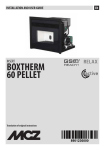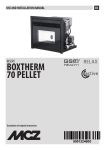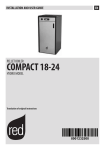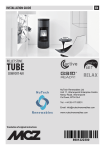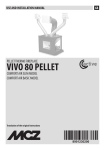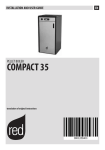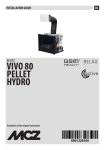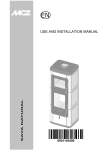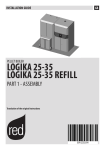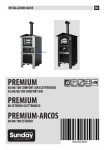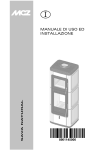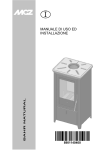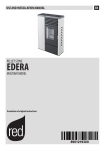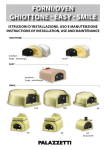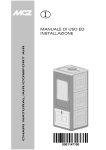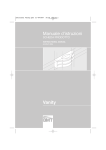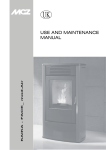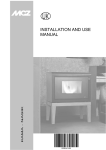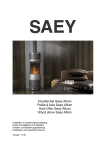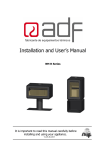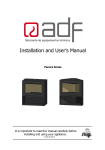Download STRIPE OVERNIGHT
Transcript
USE AND INSTALLATION MANUAL EN WOOD-BURNING STOVE STRIPE OVERNIGHT Translation of original instructions 8901177000 TABLE OF CONTENTS TABLE OF CONTENTS................................................................................................... II INTRODUCTION...........................................................................................................1 1-WARNINGS AND WARRANTY CONDITIONS..................................................................2 2-INSTALLATION INSTRUCTIONS...................................................................................5 3-DIMENSIONS AND TECHNICAL CHARACTERISTICS......................................................15 4-INSTALLATION AND ASSEMBLY................................................................................17 5-OPERATION............................................................................................................25 6-MAINTENANCE AND CLEANING................................................................................29 II INTRODUCTION Dear Customer, thank you for having chosen a product from our Wood-burning range. Products manufactured with OYSTER technology, do not consume the oxygen inside the room when installed correctly, thanks to a perfectly sealed structure, but draw all the air from outside and can therefore be installed in any well-insulated home and in passive houses. This technology eliminates all risks of smoke being released into the room and ventilation grilles are no longer required. Consequently, there will be no more flows of cold air in the room, which make it less comfortable and compromise the overall efficiency of the system. The sealed product can be installed in the case of forced ventilation or in a room in which there may be a negative pressure compared to outside. To allow for optimal product operation and for you to enjoy the warmth and sense of wellbeing that the fire can convey in your home, we advise you to read this manual carefully before starting up the product for the first time. REVISIONS TO THE PUBLICATION The content of this manual is strictly technical and property of MCZ Group Spa. No part of this manual can be translated into another language and/or altered and/or reproduced, even partially, in another form, by mechanical or electronic means, photocopied, recorded or similar, without prior written approval from MCZ Group Spa. The company reserves the right to make changes to the product at any time without prior notice. The proprietary company reserves its rights according to the law. CARE OF THE MANUAL AND HOW TO CONSULT IT • Take care of this manual and keep it in an easily accessible place. • Should the manual be misplaced or ruined, request a copy from your retailer or directly from the authorised technical assistance Department. • “Bold text” requires particular attention. • “Text in italics” is used to draw your attention to other paragraphs in this manual or any additional explanation. • “Note” provides the reader with additional information. SIMBOLOGIA PRESENTE SUL MANUALE ATTENTION: carefully read and understand the relative message because failure to comply with that which is written can cause serious damage to the product and put the user’s safety at risk. INFORMATION: failure to comply with these provisions will compromise the use of the product. OPERATING SEQUENCES: sequence of buttons to be pressed to access the menus or make adjustments. MANUAL: carefully read this manual or the relative instructions. Technical Dept. - All rights reserved - Reproduction is prohibited 1 1-WARNINGS AND WARRANTY CONDITIONS SAFETY PRECAUTIONS • Installation, functional verification and maintenance must only be performed by qualified or authorised personnel. • Install the product in accordance with standards in force in the relative place, region or country. • This product is not intended for use by persons (including children) with reduced physical, sensory or mental capabilities, or lack of experience and knowledge, unless they have been given supervision or instruction concerning use of the product by a person responsible for their safety. • Only fuel recommended by the company must be used. The product must not be used as an incinerator. It is strictly forbidden to use liquid fuel. • The user, or whoever is operating the product, must read and fully understand the contents of this instruction manual before performing any operation. Errors or incorrect settings can cause hazardous conditions and/or poor operation. • Do not use the product as a ladder or supporting structure. • Do not place laundry on the product to dry. Any clothes horses or similar objects must be kept at a safe distance from the product. Fire hazard. • All liability for improper use of the product is entirely borne by the user and relieves the manufacturer from any civil and criminal liability. • Any type of tampering or unauthorised replacement with non-original spare parts could be hazardous for the operator’s safety and relieves the company from any civil and criminal liability. • Most of the surfaces of the appliance can get very hot (door, handle, glass, smoke outlet pipes, etc.). Avoid contact with these parts unless adequate protective clothing is worn or appropriate means are used, such as heat protective gloves or cold handle systems. • It is forbidden to operate the product with the door open or the glass broken. • Switch the product off in the event of a fault or malfunctioning. • Do not wash the product with water. • Do not stand in front of the product for a long time. Do not overheat the room where the product is installed. This could affect your physical conditions and cause health problems. • Do not put any fuel other than wood in the hopper. • Install the product in rooms that are adequately protected against fire and equipped with all the utilities such as supplies (air and electricity) and smoke outlets. • If a fire breaks out inside the chimney, switch the latter off and do not open the door. Then contact the competent authorities. • The product and the ceramic cladding must be stored in a place where there is no humidity and must not be exposed to the elements. • It is recommended not to remove the feet that support the product in order to guarantee adequate insulation, especially if the flooring is made of flammable material. • If the ignition system is faulty, do not force ignition with flammable materials. • Special maintenance must only be performed by authorised and qualified personnel. • Assess the static conditions of the surface on which the weight of the product will rest and provide suitable insulation if it is made of flammable material (e.g. wood, fitted carpet or plastic). • Avoid installing the product in rooms containing B-type gas appliances, hoods with or without an extractor, heat pumps or collective ventilation ducts. • Avoid having several chimneys running at the same time in the room or being close to a stairwell. Furthermore, make sure there are no appliances in interconnected rooms, which when used simultaneously could cause a negative pressure in one of the two rooms. • The product must be used in accordance with all the local and national laws and European Standards applicable in the relative place, region or country. • Do not use volatile and/or flammable substances (petrol, alcohol, etc.) to ignite the fire. • Do not use fuel that could release toxic substances or pollutants. • Do not use water to put the fire out. • Check the external-internal air inlet and the chimney at least once a year and have them cleaned also. 2 1-WARNINGS AND WARRANTY CONDITIONS INFORMATION • • • • Please contact the retailer or qualified personnel authorised by the company to resolve a problem. Check and clean the smoke outlet pipes regularly (connection with the chimney). The product is not a cooking appliance. Keep this instruction manual in a safe place as it must accompany the product throughout its working life. If it is sold or transferred to another user, always make sure that the manual accompanies the product. INTENDED USE The product only works with wood and must be installed indoors. WARRANTY CONDITIONS The company provides a product warranty, excluding the parts subject to normal wear stipulated below, for a period of two years from the date of purchase, which is proven by a supporting document that contains the name of the seller and the date when the sale took place. Warranty cover is valid if the completed warranty is returned within 8 days and the product is installed and tested by a qualified installer, according to the detailed instructions provided in the installation guide supplied with the product. The term ‘warranty’ refers to the (free-of-charge) replacement or repairs of parts acknowledged to be faulty due to manufacturing defects. RESTRICTIONS The above-mentioned warranty does not cover parts of electrical and electronic components and fans, which are covered for two years from when the product is purchased, proof of which is provided as specified above. The warranty does not cover parts subject to normal wear, such as: gaskets, glass and all parts that can be removed from the firebox. Replaced parts will be covered by the warranty for the remaining period of the warranty in force as from the date of purchase of the product. EXCLUSIONS Variations in colour of the painted or ceramic parts and crazed ceramics do not constitute grounds for a claim as they are natural characteristics of the material and product use. The warranty does not cover any part that may be faulty as a result of negligence or careless use, incorrect maintenance or installation that does not comply with the company’s instructions (see the relative chapters in this user manual). The company declines all liability for any damage which may be caused, directly or indirectly, to persons, animals or objects as a consequence of non compliance with all the prescriptions specified in the instruction manual, especially warnings regarding installation, use and maintenance of the product. If the product does not work correctly, contact your local retailer and/or importer. Damage caused during transport and/or when handled is excluded from the warranty. The supplied manual is the only reference for installation and product use. The warranty will be rendered null and void in the event of damage caused by tampering, atmospheric agents, natural disasters, electrical discharges, fire, defects in the electrical system and maintenance not being performed at all or as indicated by the manufacturer. Technical Dept. - All rights reserved - Reproduction is prohibited 3 1-WARNINGS AND WARRANTY CONDITIONS INTERVENTION REQUEST The company declines all liability if the product and any other accessory is used incorrectly or altered without authorisation. All parts must be replaced with original spare parts. The request must be sent to the retailer who will forward it to the technical assistance department. SPARE PARTS Only original spare parts must be used. The retailer or service centre can provide all the useful information regarding spare parts. It is recommended not to wait for the parts to be worn before having them replaced. It is important to perform regular maintenance. PRECAUTIONS FOR CORRECT DISPOSAL OF THE PRODUCT IN ACCORDANCE WITH THE EUROPEAN DIRECTIVE 2002/96/EC AND ITS SUBSEQUENT AMENDMENT 2003/108/EC. At the end of its working life, the product must not be disposed of as urban waste. It must be taken to a special differentiated waste collection centre set up by the local authorities or to a retailer that provides this service. Disposing of the product separately prevents possible negative consequences for the environment and health deriving from inappropriate disposal and allows its materials to be recovered in order to obtain significant savings in energy and resources. As a reminder of the need to dispose of appliances separately, the product is marked with a crossed-out wheeled dustbin. 4 2-INSTALLATION INSTRUCTIONS The requirements stipulated in this chapter refer to the regulations of the Italian installation standard UNI 10683. In any case, always comply with the regulations in force in the country of installation. THE OPERATING ENVIRONMENT For correct operation and even distribution of heat, the product must be placed where the air required for combustion can flow, in accordance with the installation regulations and the standards in force in the country of installation. The volume of the installation environment must not be less than 25 m3. The air must enter through permanent openings in the walls that reach outside with a minimum section of 100 cm2 in the case of a nonOyster installation, i.e. without external ducted combustion air. These openings must be made in such a way that it is impossible for them to be obstructed in any way. Air can also be drawn from adjacent rooms to the one that is to be ventilated, provided they have an external air inlet and are not used as a bedroom or bathroom or where there is a fire hazard, such as: a garage, wood shed or where flammable materials are stored, and applicable regulations must be strictly complied with. • If the product is placed too close to the wall it could cause overheating and damage the plaster (yellowing, cracking, etc.). • The product must be connected to a flue or a vertical duct that can expel the smoke at the highest point of the building. • The product must be connected to a flue or an internal or external vertical duct in compliance with current regulations. • The smoke derives from the combustion of wood essence and if it comes in contact with or close to walls, the latter can become dirty. • The external air inlet must be drilled before positioning the product (except in the case of installation with Oyster technology). • The floor of the room where the product will be installed must be adequately sized to withstand its weight. POSITIONING In the case of simultaneous installation with other heating appliances, provide appropriate air inlets for each one (according to the instructions of each product). The product cannot be installed in the following places (except for sealed or closed operation appliances with external ducted combustion air intake): • in bedrooms or bathrooms; • in rooms where there are liquid fuel appliances with continuous or intermittent operation that draw the combustion air from the room they are installed in; • in rooms where there are B-type gas heating appliances, with or without domestic hot water production and interconnecting rooms; • where another heating appliance is installed without an independent air flow. It is forbidden to place the product in an explosive atmosphere. Technical Dept. - All rights reserved - Reproduction is prohibited 5 2-INSTALLATION INSTRUCTIONS SAFE DISTANCES Non-flammable walls Flammable walls A = 5 cm B = 10 cm A = 5 cm B = 20 cm STRIPE OVERNIGHT *LEAVE AN APPROPRIATE DISTANCE FROM THE WALLS IN ANY CASE FOR MAINTENANCE TO BE PERFORMED ON THE PRODUCT. If particularly delicate objects are present, such as furniture, curtains or sofas the distance of the product must be significantly increased. If the floor is made of wood, it is recommended to place a floor protection in accordance with the standards in force in the country of installation. Heat-sensitive or flammable objects cannot be placed near the product. Keep such objects at a minimum distance of 100 cm from the outermost point of the product. 6 2-INSTALLATION INSTRUCTIONS CONNECTING THE COMBUSTION AIR INLET PIPE The combustion air inlet does not necessarily have to be connected to the outside; this is only required if you wish to use Oyster technology. Always use pipes and fittings with appropriate seals that guarantee tightness. REAR VIEW OF THE STRIPE PRODUCT: 1) COMBUSTION AIR INLET Products manufactured with Oyster technology do not consume the oxygen inside the room, thanks to a perfectly sealed structure, but draw all the air from outside and can therefore be installed in any well-insulated home and in passive houses. In order to satisfy these requirements, the 80 mm diameter smoke duct for the combustion air inlet must be connected to the outside of the building. The product must be connected to the external air inlet with pipes and fittings that guarantee tightness in order to comply with the sealed product requirements (OYSTER technology). Technical Dept. - All rights reserved - Reproduction is prohibited 7 2-INSTALLATION INSTRUCTIONS OUTDOOR AIR INLET Drill a hole on the outer wall close to the product with a minimum section of 100 cm² (13 cm in diameter or 12x12 cm if square, considering the protective grids), protected by a grid on the outside. The air inlet must also: • be protected with a grid, metal mesh, etc. without reducing the net section; • be positioned in such a way so as not to be obstructed; • allow maintenance to be performed; • be directly interconnected with the room where the product is installed; • in the case of ducting, up to 3.5 linear metres, increase the cross-section by about 5%, whereas for longer ducts, increase it by 15%. Remember that the ventilation grilles always have a useful section in cm2 on one side. When choosing the grille and size of the hole, check that the useful section of the grille is larger or equal to the section required by the manufacturer for product operation. IMPORTANT! The air flow can also be drawn from an adjacent room to that of the room where the product is installed, provided the air can flow freely through permanent openings interconnected with the outside; it is forbidden to connect to thermal units, garages, kitchens or bathrooms. CONNECTION TO THE CHIMNEY The connection to the chimney is very important and must be implemented carefully. The products have an upper or rear smoke exhaust. The smoke exhaust pipe must be assembled in such a way so as to guarantee its tightness during product operation in negative pressure and prevent condensation from being formed and conveyed towards the product. Any manual draught adjustment devices inserted in the pipe must not hermetically close the internal section of the duct. These dampers must be equipped with a suitable mechanism to prevent the valve from rotating completely in the closed position. The minimum safety opening surface must be 3% of the through section and not less than 20 cm². If the smoke duct has a horizontal section, this must rise with a minimum gradient of 3-5% (3-5 cm per metre). EXAMPLE OF CONNECTION TO THE CHIMNEY The horizontal section of the smoke duct must not be longer than 2 m. It is forbidden to use flexible and fibre cement pipes. The smoke duct must not cross rooms in which it is forbidden to install combustion appliances. It is forbidden to use counter-sloping pipes. 8 2-INSTALLATION INSTRUCTIONS CONNECTING THE PRODUCT TO THE CHIMNEY The smoke outlet pipe is designed by the company for the smoke to be expelled towards the top of the product. There lies the possibility of having the smoke outlet on the back of the product by purchasing the rear smoke outlet fitting (see the following paragraph). Before installing the heat storage refractory kit, insert the optional smoke outlet fitting into the pre-assembled pipe on the product and remove the knockout circle on the rear panel of the product. REAR SMOKE OUTLET FITTING KNOCKOUT HOLE REAR SMOKE OUTLET WITH FITTING (OPTIONAL) UPPER SMOKE OUTLET Technical Dept. - All rights reserved - Reproduction is prohibited 9 2-INSTALLATION INSTRUCTIONS TOP HOLE COVER AND REAR SMOKE OUTLET FITTING (ACCESSORY) Since there lies the possibility of having the smoke outlet on the back, an accessory has been constructed (optional), which consists of the smoke fitting and the tray. The fitting, as mentioned in the previous paragraph, must be connected to the tube set-up in the product. The top hole cover is part of the standard supply of the stove top and must be applied if a rear smoke outlet is used. It must be applied to the hole designed for the vertical smoke duct. SMOKE FITTING 10 TOP HOLE COVER 2-INSTALLATION INSTRUCTIONS CHIMNEY The chimney is the fundamental element for smoke expulsion and must therefore comply with the following requirements: • Be waterproof and thermally insulated. • Be made of suitable materials that resist mechanical stress over time, heat, the effects of the combustion products and any possible condensation. • Have a vertical set-up with deviations from the axis of no more than 45° and free of bottlenecks. • Must be suitable for the specific operating conditions of the product and have the CE marking (EN1856-1, EN1443). • Must be adequately sized for the draught/smoke expulsion requirements that are necessary for the product to operate correctly (EN13384-1). • The chimney must not be shared with other appliances. • The chimney must be at least category T400 (or higher if required by the smoke temperature of the appliance) and soot-fire resistant. Resistance to moisture is mandatory if this is required by chimney size. • The internal section is preferably circular. • In the case of a pre-existing product that has been used, it must be cleaned. The chimney is fundamental for correct operation and safety of your product. A B C D A) CHIMNEYPOT B) CHIMNEY C) SMOKE DUCT D) EXTERNAL AIR INLET TYPICAL CHIMNEY INSTALLED CORRECTLY WITH A CHAMBER WITH SEALED DOOR AT THE FOOT OF THE EXTERNAL RISING SECTION, TO COLLECT AND REMOVE THE SOLID MATERIALS PRODUCED DURING COMBUSTION. In the event of poor weather conditions for product operation (low pressure, external temperature not particularly harsh, windy day), may lead to inverse draught in the chimney. In this case, it is recommended to use a little paper to ignite the fire to heat the chimney and restore normal draught. Then proceed with normal product start-up. Technical Dept. - All rights reserved - Reproduction is prohibited 11 2-INSTALLATION INSTRUCTIONS EXAMPLES OF CHIMNEYS AISI 316 steel chimney with double chamber insulated with ceramic fibre or similar material, resistant to 400°C. Refractory chimney with Traditional square-section clay insulated double chamber and chimney with insulating empty external lightweight concrete inserts. cladding with cellular material such as clay. Avoid chimneys with an internal rectangular section where the larger side is 1.5 times the smaller side (such as 20x40 or 15x30). EXCELLENT GOOD VERY POOR POOR For square or rectangular-section chimneys, the internal corners must be rounded with a radius of no less than 20 mm. For a rectangular section, the ratio between internal dimensions must be ≤1.5. The sections/lengths of the chimneys shown in the technical data table are guidelines for a correct installation. Any alternative configurations must be suitably sized in accordance with the general method of calculation of UNI EN13384-1. It is recommended for the flue duct to be equipped with a chamber to collect solid materials beneath the opening of the smoke duct, which can be easily opened and inspected through an airtight door. Should doubts arise regarding chimney performance or if its dimensions are different from those recommended, you are strongly advised to have an installer, authorised by the manufacturer, perform an inspection and evaluate the performance of the chimney. The manufacturer declines all liability regarding product malfunctioning if this is attributable to a chimney that is badly sized and installation does not comply with the stipulated requirements. 12 2-INSTALLATION INSTRUCTIONS CHIMNEYPOT Often, if this factor is underestimated it hinders smooth “chimney system” operation. The draught of the chimney also depends on its chimneypot. In the case of an artisan product, it is very important for the four expulsion sections to be more than twice the internal section of the chimney. The chimneypot will be exposed to the four winds and it is therefore recommended for it to be specifically designed to withstand the elements (e.g. an industrial chimney). INDUSTRIAL CHIMNEYPOT WITH PREFABRICATED STACKED ELEMENTS. ALLOWS EXCELLENT SMOKE EXPULSION. TRADITIONAL ARTISAN CHIMNEYPOT. THE CORRECT EXPULSION SECTION MUST BE AT LEAST TWICE THE INTERNAL SECTION OF THE CHIMNEY; IDEALLY 2.5 TIMES ITS SIZE. CHIMNEYPOT FOR A STEEL CHIMNEY WITH AN INTERNAL CONE AND SMOKE DEFLECTOR. ALLOWS EXCELLENT SMOKE EXPULSION. B 1 mt A 0,5 mt The chimneypot must comply with the following requirements: • Have an internal section equal to that of the chimney. • Have a useful outlet section that is at least double that of the internal section of the chimney. • Be constructed in such a way so as to prevent rain, snow and any foreign body from entering the chimney. • Be positioned so as to ensure adequate smoke dispersion and in any case beyond the reflux area in which counter pressure is likely to form. YES NO A) UPPER STOREY OR SOLID COMBUSTIBILITY. B) LOWER STOREY. Technical Dept. - All rights reserved - Reproduction is prohibited 13 2-INSTALLATION INSTRUCTIONS In the case of paired chimneys, the solid combustibility or upper storey chimneypot must be at least 50 cm higher than the others in order to prevent the pressure from being transferred between the paired chimneys. The chimneypot must not have any obstacles within a range of 10 metres, such as walls, slopes and trees. In this case, raise it at least 1 m above the obstacle and in the case of other chimneypots nearby, leave a gap of at least 2 m. In any case, the chimneypot must exceed the highest point of the roof by at least 1 m or be above the reflux area, which is equal to 130 cm in roofs with a gradient greater than 10° (perpendicular height to the surface of the roof). 14 3-DIMENSIONS AND TECHNICAL CHARACTERISTICS STRIPE OVERNIGHT STOVE * DIAMETER OF THE SMOKE OUTLET Technical Dept. - All rights reserved - Reproduction is prohibited 15 3-DIMENSIONS AND TECHNICAL CHARACTERISTICS TECHNICAL CHARACTERISTICS STRIPE OVERNIGHT Type of fuel Wood - logs Hourly consumption 2,0 kg/h – 0,9 kg/h Reloading/load time 45’/1,5 kg Nominal output power kW 7,2/Kcal 6192 Minimum output power kW 3,5/Kcal 3010 Efficiency 83,1% CO emission in the smoke (13% O2) 0,09% Particulate/OGC/Nox (13%O2) 33,3 mg/Nm3 (13% O2)/ 69 mg/Nm3- 115 mg/Nm3 Smoke flow rate 6,9 g/s Smoke temperature 230 °C Recommended draught 12 Pa / 0,12 mbar Heatable volume m3 151/40 – 172/35 – 201/30 * Smoke outlet Ø 15 cm Firebox dimensions H=430 mm P=240 mm L=350 mm Net weight 125 kg stove + kg 65 storage External combustion air inlet 100 cm2 Chimney Chimney section 18x18 cm Ø18 Minimum chimney height 4m Notes * These data may vary according to the type of fuel used. The stove is an intermittent combustion appliance. Tested according to EN 13240 in accordance with Directive 89/106/EEC (Construction Products). 16 4-INSTALLATION AND ASSEMBLY IMPORTANT! The product must be installed and connected to the chimney by a qualified technician or competent personnel in order for all local or national regulations to be complied with and in any case in accordance with UNI 10683. When the product and the relative frame are unpacked, verify that every part is in perfect working order and no damage has been caused during transport. If the product is installed in a place that is difficult to access, the weight can be reduced by removing the internal elements of the firebox. It is recommended to set each element back in place correctly. PREPARATION AND UNPACKING The product is delivered on pallets with various packaging. • One contains the structure of Fig. 1. • A pallet containing the refractory parts, the cardboard box containing the sides and the box containing the top Fig.2. Open the package and remove the boxes. Once the package is open, remove the two brackets that block the product to the pallet (Fig. 3). Remove the two screws A and the other three screws B that block the bracket to the pallet and set the product in the pre-selected place, making sure this complies with the requirements. FIG. 1 - STRIPE PACKAGE FIG. 2 - PACKAGE OF REFRACTORY PARTS AND BOX WITH SIDES AND TOP FIG. 3 - REMOVING THE PACKAGE SCREWS Technical Dept. - All rights reserved - Reproduction is prohibited 17 4-INSTALLATION AND ASSEMBLY The product must always remain in a vertical position and handled solely with a forklift. Pay particular attention to the door and its glass, protecting them from mechanical knocks that would compromise their integrity. In any case, the product must always be handled with care. If possible, unpack the product near the place of installation. The packaging materials are neither toxic nor harmful, and therefore no particular disposal measures are required. The end user is responsible for product storage, disposal or possible recycling in compliance with the relative applicable laws. ASSEMBLING AND ADJUSTING THE FEET The product requires the support feet to be assembled, whose function is to adjust the product level for it to be aligned and stable on the ground. The feet are screwed to the base of the structure and they can be applied as shown in the figure and adjusted with a screwdriver by acting on the head of the feet. For an effective closing function of the doors, adjust the feet for there to be a difference of 2 mm between the front and rear of the base (see figure). A = B+2 MM A B ASSEMBLING THE STORAGE PANELS The storage parts can now be assembled. The storage consists of: STORAGE A B C D E F NO. OF ITEMS 4 4 1 1 2 1 18 4-INSTALLATION AND ASSEMBLY Proceed with the installation as follows: • Place the two parts E on the base of the smoke fitting. • Place part F on the upper part of item E. • Place part D on the right side of part E and part C on the left side. Place the following on top of these parts, which form the base: • Part A (4 items in all). • Part B interlocks on part A (4 items in all). SIDE VIEW FRONT VIEW Technical Dept. - All rights reserved - Reproduction is prohibited REAR VIEW 19 4-INSTALLATION AND ASSEMBLY ASSEMBLING THE SIDE CLADDING The metal sides are not particularly difficult to install. The main precaution is to install the sides of the product only when the latter is set in place. Moving the product with the sides assembled might damage the flooring. Firstly, place the front panel (with the hole for the door) on the structure of the product with the side holes of the panel in line with the holes on the structure of the product. Open the stove door to place the fron panel in its housing (FIG.A). Fasten the panel with the three screws on the right and the three screws on the left. IMPORTANT: When you place the front panel on the structure it is necessary to match the knob up with the hole in the panel. INTERNAL PANEL FIG.A PANEL FASTENING FRONT PANEL FASTENING 20 HOLE IN PANEL KNOB 4-INSTALLATION AND ASSEMBLY Then bring the two profiles near the front panel making sure the flap of the panel enters the seat on the profile. HOUSED PROFILE PROFILE TO BE BROUGHT NEAR THE FRONT PANEL Before installing the rear panel, centre and fasten the air adjustment knob. Hold the knob in line (frontally) with one hand and fasten the screw from behind the stove with the other. Technical Dept. - All rights reserved - Reproduction is prohibited 21 4-INSTALLATION AND ASSEMBLY Then bring the rear panel and enter it in the pins found on the lower part of the product. PINS 22 4-INSTALLATION AND ASSEMBLY Once the above is completed, block the front and rear panels and profiles with the two fastening plates. As shown in the figure, fasten the plate (one on the right and the other on the left) with the two screws in the holes on the front and rear panels. The plate must slide into the top part, under the two edges of the front and rear panel and then fastened from the top with the two screws. Technical Dept. - All rights reserved - Reproduction is prohibited 23 4-INSTALLATION AND ASSEMBLY ASSEMBLING THE TOP Place the top on the upper part of the product making sure the spacers on the bottom part of the top enter the holes on the structure. TOP SPACERS OF THE TOP BOTTOM VIEW OF THE TOP 24 5-OPERATION START-UP PRECAUTIONS Make sure you have read and fully understood the contents of this instruction manual. Remove all components that could burn from the firebox and door (instructions and various adhesive labels). Remove the stickers from the ceramic glass otherwise the high temperature could melt them and cause irreparable damage to the glass. The product can be positioned at an angle or against the wall. Avoid touching the product during the initial start-up, as the paint completes its drying process and hardens during this phase. It is good practice to guarantee effective ventilation in the room during the initial start-up, as the product will emit some smoke and smell of paint, which is absolutely normal! If necessary, touch up the paint with the spray can of the specific colour. Do not stand close to the product and air the room. The smoke and smell of paint will disappear after about an hour of operation, however, remember they are not harmful in any case. The product will be subject to expansion and contraction during the start-up and cooling phases, therefore light creaking noises may be heard. This is absolutely normal as the structure is made of laminated steel and must not be considered a defect. It is extremely important to make sure the product is not immediately overheated and the temperature increases gradually. This will prevent damaging the welds and the steel structure. Do not expect heating efficiency immediately! FUEL FUEL: Wood In order to achieve maximum efficiency from your product, it is of utmost importance to use wood with adequate characteristics. Oak-beech-ash-locust wood or logs of non-resinated pressed logs can be used. The latter have a high calorific value and must be used with caution to avoid overheating that could damage the product. Fuels such as poplar-pine-linden-chestnut have a low calorific value as the wood is soft. Moisture content is fundamental for all the listed types of wood. Wood drying time (e.g. beech) Moisture % Calorific power Kcal/h Freshly cut 50 / 3 Months 40 2410 6 Months 35 2700 9 Months 30 2900 12 Months 25 3150 15 Months 20 3400 18 Months 15 3710 21 Months 10 3980 Technical Dept. - All rights reserved - Reproduction is prohibited 25 5-OPERATION A high percentage of moisture causes condensation in the smoke duct, thereby causing an alteration to the draught and generating smoke and considerable soot deposits in the firebox, on the glass of the door and on the chimney, with the subsequent risk of this catching fire. It also leads to a much lower overall efficiency. Damp or treated wood releases more smoke than usual, which could dirty the glass more quickly. Poor chimney performance can also compromise the cleanliness of the glass, as the smoke remains in the combustion chamber longer than usual. Do not use treated fuels (painted or lacquered wood) or non-compliant fuels (plastic or derivatives), which could release toxic substances or pollutants. Do not burn waste. The gases produced by combustion of unsuitable fuel could damage the product, the chimney and pollute and compromise your health. USING THE STOVE OPENING/CLOSING THE DOOR The product is equipped with automatic door closure. Use the leather glove supplied to pull the handle towards you to open the door. Simply let go of the handle and the door will close automatically. NOTE: for the door closing system to work properly, the product must be installed according to the feet adjustment guidelines in Chap. 4. FUEL LOADING To load the fuel, simply open the door by lifting and pulling the handle towards you. The metal parts and the glass become very hot during operation, therefore use adequate protection. The door to the combustion chamber must remain closed during combustion. It is forbidden to load larger amounts of fuel than those specified in the technical data sheets of each individual product. An excessive amount of fuel in the combustion chamber could damage and deform the firebox and the structure of the product. The company cannot be held liable for any damage caused by fuel overloads or if non-compliant fuel is used. COMBUSTION CONTROL Combustion and therefore the combustion air intake is controlled via a single control knob. The inlet air is either: PRIMARY AIR: the primary air is pre-set and is mainly delivered to help the ignition process of the product. SECONDARY AIR: the introduction of secondary air is pre-set and is used for the partial cleaning of the glass and allows the completion of the combustion process. Thanks to this process, heating performance and efficiency of the product are enhanced. 26 5-OPERATION ADJUSTING THE AIR WITH THE PUSH-PULL SYSTEM Press the air adjustment knob, which will slightly emerge from its seat thanks to a spring and it can then be turned to the left or right according to the increase or decrease in combustion air that is to enter the combustion chamber. The primary and secondary air intake is pre-set; the primary and secondary air intake is adjusted by moving the knob. Once the adjustment is complete, the knob is pressed once again for it to enter its seat. AIR ADJUSTMENT KNOB POSITIONS 1-2-3 AIR ADJUSTMENT KNOB IN POSITION 2 PRIMARY AIR KNOB (TURNED TO THE LEFT) The knob turned to the left (i.e. counter-clockwise) in pos. 3 is designed to bring a large amount of air into the firebox, to allow a rapid and effective ignition of the fire. SECONDARY AIR KNOB (IN POSITION 2) Secondary air, as mentioned above, allows the combustion process to be completed and enhances efficiency (knob in pos. 2). The position of the knob determines the nominal output, thereby minimising the primary and secondary air intake. KNOB TURNED TO THE RIGHT Turn the knob clockwise to position 1 in order to decrease the amount of air in the combustion chamber as only a minimum amount of primary air is drawn. This position is used to prolong combustion (for instance, at night, or when you are not at home) so that the product is set to minimum, the fire is kept on while achieving savings on fuel. Technical Dept. - All rights reserved - Reproduction is prohibited 27 5-OPERATION FIRST IGNITION A NOTE REGARDING PAINT EXHALATION It is recommended to air the room before the first start-up to evacuate any smells and/or fumes emitted by the paint during the drying and hardening phase due to the heat. Do not stand close to the stove and air the room. The smoke and smell of paint will disappear after about an hour of operation, however, remember they are not harmful in any case. It is recommended to first start-up the product with caution, using fine and seasoned wood. The combustion air inlet must be completely open. When combustion has started, normal sized wood can be introduced. The flame must be as laminar as possible. Each time the wood is loaded, the door must be opened slowly to prevent smoke blow back in the room. Proceed as follows: • Place a small ball of scrunched up paper into the product. • Cover the paper with a few twigs and a few pieces of wood. • Turn the lever completely to the left (pos. 3). • Light the paper and if necessary keep the door ajar for a few minutes until the combustion chamber and the flue begin to warm up. • The door can be closed once the twigs start to burn. As the fire gradually burns, add wood. Never overload the product with wood (see the technical data in the table). As soon as the flames have died down and a bed of embers has formed, load the product normally. Small loads are preferable to large loads of wood for combustion. It is recommended to adopt this fuel loading method also in subsequent product use. To achieve the nominal output and optimal combustion, load the amount of wood and comply with the loading interval indicated in the technical data table (Chapter 3). 28 6-MAINTENANCE AND CLEANING All the cleaning operations of all parts must be performed with a completely cold product. CLEANING PERFORMED BY THE USER CLEANING THE GLASS The glass can be cleaned with specific products (see our price list), a cloth soaked in a water and ammonia solution or a little white ash and a sheet of newspaper. It takes longer to clean if there is any soot build-up and dirt. Do not spray the cleaning product on to the painted parts or the seals of the door (ceramic fibre cord). The ceramic glass installed on the manufacturer’s products have a heat resistance of approximately 750°C and are tested and checked before and after assembly to check for any cracks, bubbles and swelling. Despite the high resistance to temperature, the glass is a fragile element and it is therefore recommended to handle the door carefully without slamming or forcing it. The glass can break as it is not a flexible element. Moreover, this type of glass does not shatter or burst and should it break, for the above reasons, only a crack will form. CLEANING THE UPPER CALORITE DEFLECTORS They require no special care. Even though the internal deflectors of the combustion firebox are made of effective yet porous material, they must be replaced after prolonged use due to wear, damage caused when their thickness is reduced to half or broken. CLEANING THE ASH This must be performed with the product turned off; it is recommended to thoroughly clean the ash pan to ensure correct combustion. Open the door, remove the grille and the ash pan using the supplied cold handle. Clean also any ash deposits in the pan compartment. Hot ashes must be stored outside with utmost care and not thrown into the dustbin. Allow them to cool down in the open air in a metal container. Technical Dept. - All rights reserved - Reproduction is prohibited 29 6-MAINTENANCE AND CLEANING CLEANING STAINLESS STEEL AND SATIN-FINISHED SURFACES These surfaces do not usually require any specific treatment besides not being cleaned with abrasive materials. It is recommended to clean stainless steel and satin-finished surfaces with a paper towel or a dry, clean cloth soaked in nonionic surfactant-based detergent (<5%); a spray cleaner for glass and mirrors can also be used. CLEANING PAINTED PARTS Avoid cleaning the painted parts with damp cloths when the product is on or hot so as to prevent thermal shock of the paint and its consequent detachment. Do not use abrasive or aggressive materials or products. Clean with a paper towel or damp cotton cloth. The silicone paints used to coat the products have top quality technical properties that allow for resistance to very high temperatures. However, there is a physical limit (380°- 400°) beyond which the paint loses its characteristics and begins to “whiten” or “vitrifies” (over 450°) and can flake and peel off the steel surface. If this occurs, temperatures well above those at which the product should operate have been reached. It is therefore recommended to use the amount of fuel specified in the technical tables. CLEANING THE CHIMNEY Mechanical cleaning of the chimney is mandatory at least once a year; excessive unburned waste can cause problems when the smoke is expelled and start a fire in the flue itself. CLEANING TO BE PERFORMED BY QUALIFIED PERSONNEL ATTENTION: the frequency with which the product is to be cleaned is based on its use and the type of installation. The company recommends contacting an authorised service centre for end-of-season maintenance and cleaning to be performed on the entire flue system as the above-mentioned operations will also be performed together with a general inspection of the product. EMERGENCY If for any reason the fire in the combustion chamber must be put out suddenly and quickly or a fire has ignited in the chimney, act as follows: • Time permitting, remove the embers and ashes using a metal container. • Request immediate help from the relative organisations. 30 MCZ GROUP S.p.A. Via La Croce n°8 33074 Vigonovo di Fontanafredda (PN) – ITALY Telephone: 0434/599599 r.a. Fax: 0434/599598 Internet: www.mcz.it e-mail: [email protected] For further technical information regarding installation or operation please contact the TECHNICAL ASSISTANCE – AFTER-SALES DEPARTMENT Monday to Friday 8.00 to 12.00 and 14.00 to 18.00 8901177000 REV.0 07/09/2012




































